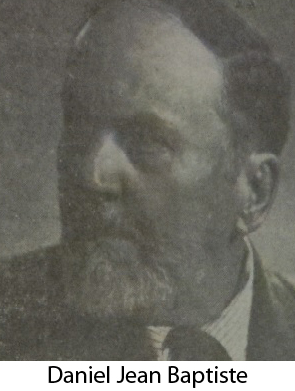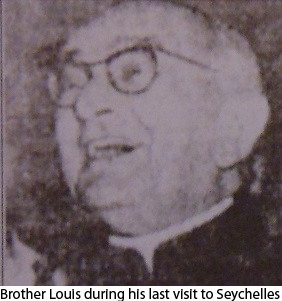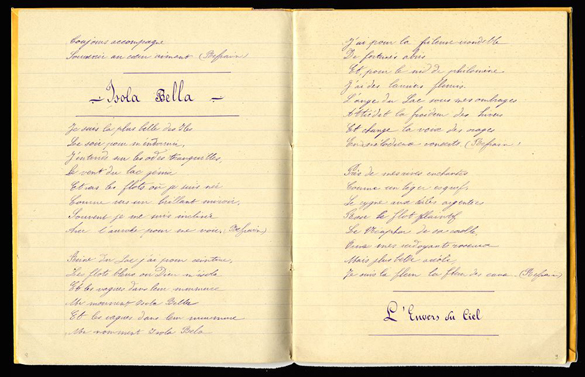More Anomalies in the book “Brève Histoire du Diocèse de Port Victoria "
I wish to thank my friend Jean-Claude Mahoune for pointing out a few typing mistakes that crept in my previous article in Today’s your issue of 25 August 2015 regarding Friar Léon. Firstly, I wrote that he was born in 1951, in fact he was born in the diocese of Tarentaise in Savoy on 12 March 1825. And secondly “In 1951 the first chapel was not built”… should have been “In 1851.”
On page 78 in the above quoted book, it is said that the first Christian Brothers who arrived in 1867 were known as Brothers of the Christian Schools. In fact they were also known as De la Salle Christian Brothers. Today they are in 84 countries and they are still being referred to as De la Salle Christian Brothers simply because the institution was founded by Jean-Baptiste de la Salle. 
On the same page we are told that the Marist Brothers (who replaced the De la Salle Brothers in 1884), composed the much loved song “Isola Bella” (beautiful Island). This is again a fantasy invented by the Roman Catholic high hierarchy. We were taught to sing it at their school and were told that it was, a “Vielle Chanson du Collège de Saint Louis (des Frères Maristes) composée par Daniel Jean Baptiste Varigault.
The latter became one of the Seychelles’ best poet, linguist and a staunch fighter for press freedom. He was born at Mahé on 16 April 1886 and died in Italy as a poor man in 1955, with only three persons attending his funeral cortege.
Varigault spoke seven languages; he was also apparently a musician and left the Seychelles to study for the priesthood in Europe. He studied in England, France and Spain.
After his studies, he went to South America where he worked as a journalist in Chile, Peru and later set up his own printing press in Brazil. It was in Brazil that he set up his own newspaper called “La Revue des Revues de l’Amérique du sud” in which he published many of his poems. It is said that the most beautiful one was dedicated to his childhood sweetheart and many of them were very nostalgic, especially this line, “Emportez-moi là-bas où tout fleurit encore
Où frémit la chaleur sous un ciel toujours pur
L'hiver devient l'été, la nuit cède à l'aurore ». His longest poem of 11 pages was « Le Pain et le Poete » which he wrote in 1928 while in Italy. Little is known why he later add de Valenfort to his surname.
He was apparently behind a failed coup d’état in Brazil and had to run away from the country. When he returned he was incarcerated in Rio de Janeiro (River of January), and his printing press was confiscated. He later left for Italy where he set up a travel agent.
 I firmly believe what I was told at school that Varigault composed that song and that it was put into music by Brother Luis Agustin (Jaime Clomier Lluis) a Spanish known as Brother Louis, who was the band master at the College of St Louis at Mahé at that time. Brother Louis arrived in the Seychelles in 1920 and was a teacher of Latin, French and music.
I firmly believe what I was told at school that Varigault composed that song and that it was put into music by Brother Luis Agustin (Jaime Clomier Lluis) a Spanish known as Brother Louis, who was the band master at the College of St Louis at Mahé at that time. Brother Louis arrived in the Seychelles in 1920 and was a teacher of Latin, French and music.
Things changed when late last year I received an interesting mail from Mr Bernard Georges on the research of Mr David Thomas on the history of the “Isola Bella”. Based on his research I requested Elien Samé an old friend of mine in La Rochelle to help further. He contacted someone at île de Groix a commune in the department of Morbihan. There interestingly, their famous chanson populaire since 1910 is “La belle île de Groix”(see 1 below from Mr Thomas Documents) has nearly the same lyric as “Isola Bella.” They did not know anything regarding the Seychelles connection and suggested without any lead that it might have come from the “Isola Bella” the small and beautiful island in the north of Italy whose famous villas were finance by rich Roman Catholic Cardinals.
After reading the other interesting part of Mr. Thomas’ research, I have come to the conclusion that Varigault was not the writer of the Seychelles version, he only presumably rephrased some lines of the original version of “Isola Bella”, from the copybook of Ste Thérèse of Lisieux (vide 2 below from David Thomas document).
 Later Father Simon (George Louis) Riffieux who used to work with the Marist Bothers (before he was posted to La Digue), wrote his own version (vide no 3 below) while he was at La Digue from 1928-1932, on the same tune as that of “Isola Bella” of the Seychelles. More research should be done to know if the “La belle île de Groix”, “Isola Bella” of Ste Thérèse Lisieux, and “Isola Bella” of the Seychelles had the same tune.
Later Father Simon (George Louis) Riffieux who used to work with the Marist Bothers (before he was posted to La Digue), wrote his own version (vide no 3 below) while he was at La Digue from 1928-1932, on the same tune as that of “Isola Bella” of the Seychelles. More research should be done to know if the “La belle île de Groix”, “Isola Bella” of Ste Thérèse Lisieux, and “Isola Bella” of the Seychelles had the same tune.
However, the “Isola Bella” was made popular in the Seychelles by Brother Louis. When Brother Louis arrived in the Seychelles, Varigault was studying in Europe and it seems that they never met because he never came back to the Seychelles. The “Isola Bella” was later used as a signature tune for Radio Seychelles.
According to Dr Maxime Ferrari, a former student of the Marist Brothers, the version of Father Simon was sung during the visit of Brothers Louis and Philogone (Angleo Meacci Philigono) in the late 1972 at the invitation of the “old boys” (his former students). He also said that Brother Louis visited the Seychelles again for the last time in 1976 as guest of the Government for the Independence celebrations. He was accompanied by a young Spanish Brother.
Mr Thomas made an interesting conclusion on the origin of the “Isola Bella” viz: “it is not clear if Saint Therese actually wrote these words or if she simply transcribed them into her cahier scolaire but it is worthwhile noting that she actually died in 1897. Varigault would have been 11 years old at that time. Furthermore, one would assume that her 'cahiers scolaires' would date earlier from her school days, presumably even before Varigault's birth. I realise that this information only adds to the conundrum instead of resolving it. However, it does cast doubt on the notion that Varigault wrote Isola Bella”.
I would also like to add that contrary to what have been said regarding the departure of the Marist Brothers from the Seychelles (on page 78), according to the authors, it was “due to the impracticable exigencies of [Mr Giles], the Director of Education”. In fact, they left (like the De la Salle Brothers) because the unbearable pressure and the racist attitude of the Roman Catholic Bishops.
As for the Dominican father, Reginald Janssens (on page 53) he was a reactionary man (a great supporter of Salazar and Franco and also the Neutron bomb), who was expelled from Mauritius by Bishop Margéot (later Cardinal). The latter asked Bishop Maradan to takehim to the Seychelles instead of sending him back to Belgium his native place.
The Lazarist Monsieur Demonier left the Seychelles on board the flute La Siene in June 1773 and not on board La Perouse. Lapérouse was in fact the captain of La Siene and his full name was Jean-François de Galoup comte de Lapérouse.
Julien Durup
a student of history
- La belle ile de Groix ?
" Je suis la plus belle des îles,
le soir pour m'endormir,
J'entends les ondes tranquilles,
le vent du large gémir;
Et vers les flots où je suis née,
comme vers un brillant miroir,
souvent je me suis inclinée,
avec l'aurore, pour me voir.
Refrain
Reine d'Atlantique,
j'ai pour ceinture,
les flots bleus où le goémon croît;
Et les vagues, de leur murmure,
me nomment la belle île de Groix"

2. Isola Bella in the above copybook of Ste Thérèse of Lisieux
Je suis la plus belle des Iles
Le soir pour m’endormir
J’entends sur les ondes* odes tranquilles
Le vent du lac gémir ;
Et vers les flots où je suis née
Comme vers un brillant miroir,
Souvent je me suis inclinée
Avec l’aurore pour me voir. (Refrain)
Reine du Lac j’ai pour ceinture,
Les flots bleus où*ou Dieu m’isola
Et les vagues dans leur murmure
Me nomment Isola Bella
Et les vagues dans leur murmure
Me nomment Isola Bella *Bela
The supposed ISOLA BELLA of Daniel Varigault
" Je suis la plus belle des îles,
Le soir pour m'endormir,
J'entends les ondes tranquilles,
le vent du large gémir;
Et vers les flots où je suis née,
Comme vers un brillant miroir,
Souvent je me suis inclinée,
Avec l'aurore, pour me voir.
Refrain
Reine des mers j'ai pour ceinture,
les flots bleus où Dieu m’a placée;
Et les vagues, de leur murmure, ) bis
Me nomment l’aimable Mahé) bis
2
Près des mes rives enchantées
Comme un léger esquif..
L’oiseau aux ailes argentées
Rose les flot plaintif.
Et mille fleurs de leur corolle
Ornent mes verdoyants coteaux.
Mais plus belle est mon auréole
Je suis la fleur des eaux.
3. The Isola Bela of Father Simon
Ref : Reine des mers, j’ai pour ceinture,
Les flots bleus où Dieu m’a placée.
Et les vagues dans leur murmure,
Me nomment La Digue enchantée,
1èreSt. Je suis la plus belle des îles,
Le soir pour m’endormir,
J’entends sur les ondes tranquilles
Le vent des mers gémir,
Et ver les flots où je suis née
Comme vers un brillant miroir,
Souvent je me suis inclinée,
Avec l’aurore pour me voir.
Refrain
2eSt : J’ai pour la gentille hirondelle
De verdoyants abris :
Et pour le nid de tourterelle
J’ai des lauriers fleuris.
L’ange des mers sous mes ombrages,
Rafraîchit ? les Zéphyrs brûlots
Et change la voix des orages
En dèsaccords attendrissants.
Refr.
3e Et sur mes rives fortunées
Comme un léger esquif
L’oiselle aux îles argentées
Rase le flot plaintif
Et mille fleurs de leur corolle
Prennent mes ravissants côteaux
Mais plus belle, la fleur des eaux
Refr.



